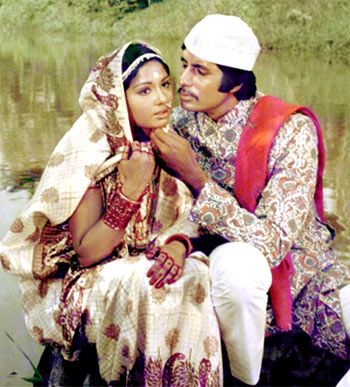 In this special series, we re-visit great Hindi film classics. Today, we look back at Amitabh Bachchan and Nutan's 1973 film Saudagar.
In this special series, we re-visit great Hindi film classics. Today, we look back at Amitabh Bachchan and Nutan's 1973 film Saudagar.
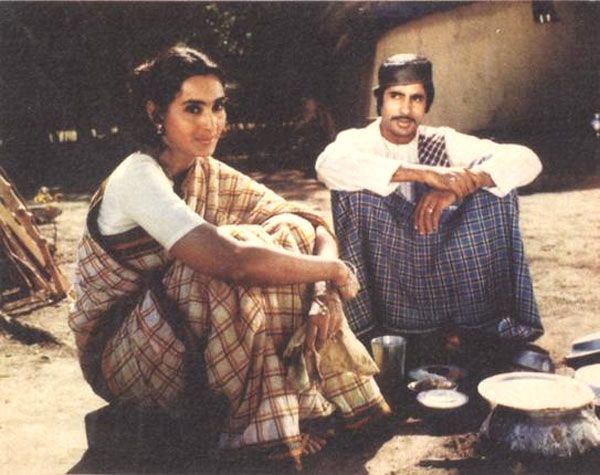
In 1973, Amitabh Bachchan had six releases: Bandhe Haath, Gehri Chaal, Abhimaan, Namak Haraam, Saudagar and Zanjeer.
Every single role showcases a distinct facet of his personality yet it was the angry, avenging cop of Zanjeer that paved the path for a remarkably flourishing career.
Somewhere in this grand scheme, Bachchan became too infallible, too mega, too predictable.
Saudagar is a modest reminder of his accomplishments (and versatility) before that.
An underrated offering from veteran art director-turned-filmmaker Sudhendu Roy, the 1973 parable is a faithful adaptation of acclaimed Bengali writer Narendranath Mitra’s short story, Rus.
Set against the Muslim community of an idyllic West Bengal village, Saudagar focuses on a lanky Bachchan playing a patali gur (palm jaggery) trader named Motalef aka Moti. Sporting a wardrobe of chequered blue lungis, bright shirts, ghamcha scarves and lively skullcaps, the scheming, shallow and self-seeking Moti’s singular ambition is to marry a pretty maiden.
Can I stress on the word 'pretty' again?
It’s crucial to the choices he makes and, eventually, pays for Moti, as highlighted amply in the opening song Har Haseen Cheez Ka Main Talabgar Hoon, rates beauty above brains and picks seduction over soul.
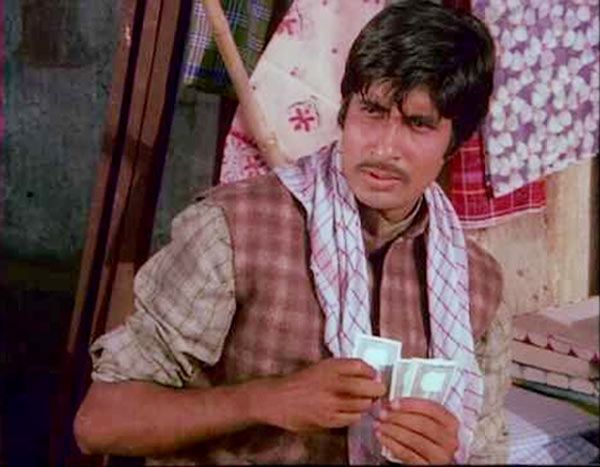
Business is fairly decent but not good enough to pay a hefty mahr, a certain amount the groom is required to offer to the bride’s father as some sort of security blanket in case of divorce or death.
Father of Phoolbanu (Padma Khanna), the village nymphet Moti has set his heart on, demands a whopping Rs 500 -- a huge sum for a man who roughly scrapes together 10-15 bucks a day.
Despite the disconcerting nature of this custom, the practical disposition of the characters and their cultural conditioning considerably cushions the indelicacy of such negotiations. A certain R K Gupta (Trishul) would surely approve.
The story’s other strong link is Nutan’s sharp-tongued Mahjubi and the real reason behind Moti’s popularity in the market. Turning the palm sap he regularly collects into delectable rounds of golden gur (jaggery), Mahjubi is the best in the business and knows it too. They haggle over her demand for a raise in a manner so realistic, a dozen scenarios popped up in my mind relating to such familiar conversations so commonplace in day-to-day living.
Fending for herself since her husband’s demise, Mahjubi, slightly older than Moti (six years in real life), doesn’t harbour any romantic notions about her future. Sensing her concealed vulnerability beneath the hardened exterior, Moti hatches a devious scheme of proposing marriage to the unsuspicious widow. That way, he doesn’t have to pay for the seasonal gur she excels in and still make a killing in the market.
Bottomline: Mission Rs 500.
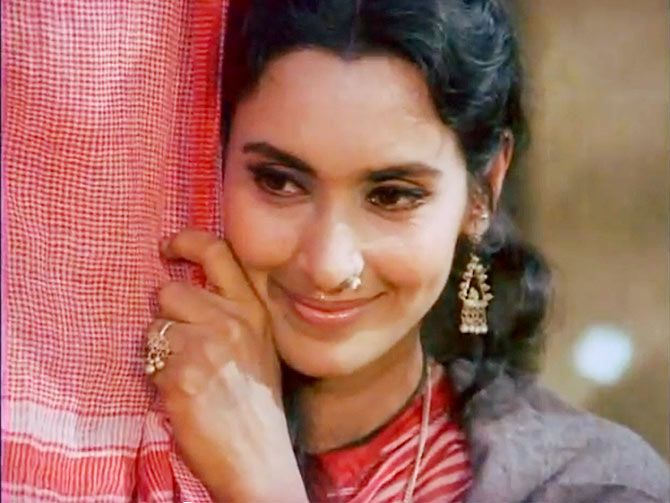
Following the linear, lucid tone of its original source, Roy doesn’t embellish his 130-minute narrative with needless subplots or excessive frills other than indulging in Ravindra Jain’s sprightly soundtrack (Sajna Hai Mujhe Sajna Ke Liye, Tera Mera Saath Rahe) to render it any more cinematic than it ought to be.
Interesting how both melodies perfectly capture the personality of the two ladies, their experiences and expectations from Moti -- airhead Phoolbanu thrives on charm while a rock-solid Mahjubi toils hard for the spouse to prosper.

Meanwhile, staying true to Mitra’s descriptive passages, Roy studiously looks into the elaborate procedure of making jaggery. A leggy Bachchan rolls up his lungi to mount atop palm trees and collect palm nectar in earthen pots, systematically honing his blade to strip off the trunks.
Back home, Nutan boils the accumulated sap vigorously stirring till it’s attained a treacly texture and finally pours them in earthen pots to set. The process is both -- educational and delicious to watch.
Shot in the picturesque Kamduni, about 20 km from Kolkata, the open-air imagery of lush green fields, palm orchards, bamboo door huts, tiny boats, rich soil and radiant ponds adds to the authenticity of its bucolic ambiance, enhancing the storytelling immensely.
'(Roy) was a seasoned art director but he designed a look that moved away from studio sets to outdoor locations, which gave the film a realistic look,' concurs Bachchan in his biography, To Be or Not To Be.
If the lifestyle at the grassroots is what provides Saudagar its serenity, in Nutan’s spunk lies its spine. She’s absolutely knock out in the scene where Moti asks for a divorce to marry Phoolbanu.

Even as Roy refrains from showing us Moti’s shame or lack of it by keeping Bachchan’s back to the camera, Nutan explodes on the screen in disgust and rebukes him for his offensive, untrue reason to split.
Unwilling to give him the satisfaction of seeing her in pain, she scornfully demands, 'Chal bol de woh alfaaz jinko zubaan pe laane ke liye tu itna bechain ho raha hai.” (Go ahead, say the words you’ve been so desperate to utter.')
The honeymoon for Moti and his attractive new bride is short-lived. They’re good for each other’s libido but she’s not the wife he took for granted in Mahjubi.
Subtle as it is, Saudagar notes the inconsistencies of an ageist society -- the women always get a raw deal. Nutan’s character remarries too. But while Moti’s wife is much younger, she gets a 50-year-old and father of three.
Given that the film devotes a substantial chunk of its screenplay to demonstrate how correct gur is prepared, it’s easy to see when Phoolbanu goes terribly wrong in prematurely setting the crudely cooked molasses. Moti’s furious response to Phoolbanu’s failings is a conclusive confirmation of his nasty temperament.
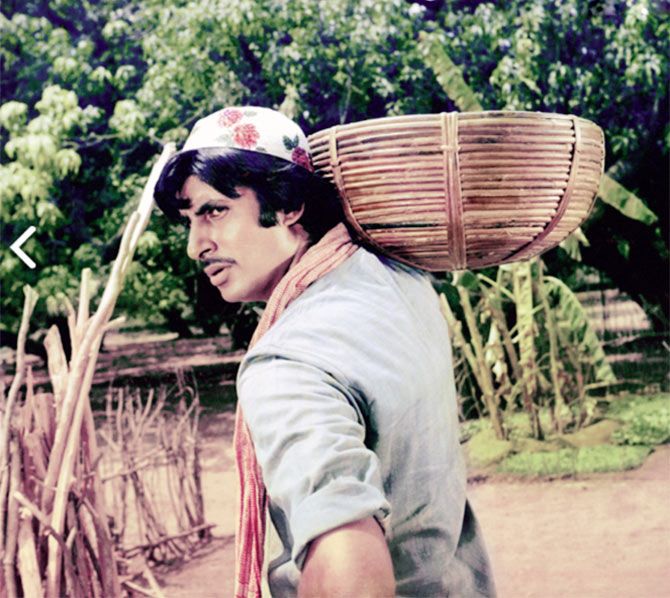
Bachchan gets under the skin of his foul, flawed, frustrated skin without turning him into an outright villain. Despite his underhandedness, there’s credibility in his humiliation and remorse. His Moti earns my pity if certainly not support.
Padma Khanna’s limitations magnify in the presence of her skilled co-stars. The sexy dancer, best known for her steamy striptease in Johny Mera Naam, is out of her depth as the jejune Phoolbanu. It’s a role that demands Rekha’s nuanced sauciness but is jarred by Khanna’s oversexed delivery.
Except Nutan and Bachchan hold fort steadily through their underplayed artistry conveying a unique equation at three different levels of the script -- professional, personal and, ultimately, humane.
A well-made, evocative slice of moral science and magnanimity, free from the shackles of formula, stereotypes and melodrama, the glow of Sudhendu Roy’s Saudagar perseveres.
Just like AB’s final dialogue in the movie, 'Aag abhi nahi bujhi.'










